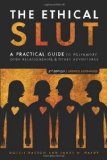I am leading a read-along of the Ethical Slut, 2nd edition. Previous installments include the Introduction, Personal Background and Chapter 1. In this installment we examine Chapter 2, “Myths and Realities.”
“We have no culturally approved scripts for open sexual lifestyles; we need to write our own. To write your own script requires a lot of effort, and a lot of honesty, and is the kind of hard work that brings many rewards. You may find the right way for you, and three years from now decide you want to live a different way — and that’s fine. You write the script, you get to make the choices, and you get to change your mind too.” -from The Ethical Slut

Many of the readers of this series are interested in the differences between the two editions of this book. A simple glance at the table of contents of both books shows that while similar topics are covered throughout, the organization has been greatly improved. The first section of the book, “Welcome,” is now limited to 6 chapters of introductory material. This is followed by The Practice of Sluthood, Navigating Challenges, and Sluts in Love. There are a total of 22 chapters plus a conclusion, glossary and resource guide.
Chapter 2 deals with a very similar subject matter to what was once found in Chapter 3 of the first edition (then titled “Paradigms, Old and New”). This chapter continues the work begun in the first chapter by examining myths people may have about the sexually and emotionally voracious and then continuing to redefine what an ethical sluthood could and should mean.
Groggette, who has been participating in our read-along, wrote an essay on her blog about how she came to sluthood. It makes a great entry point to this chapter which is all about how people view sluts — and by extension, the cultural baggage all of us in the Western world carry when we attempt to explore lifestyles outside the norm. The truth is that while this book focuses on sexual decisions, and specifically the roads people travel toward sluthood and non-monogamy, the core concepts of this chapter can apply to almost any aspect of life.
No matter our upbringing, none of us can know what it would be to be raised in a fully sex-positive, healthy and sane society. We may have chosen to be part of healthier subcultures (or in some cases been raised in them) but we’re still part of a larger world that tries daily to suggest certain paths for our lives — through media showing us the lives we are “supposed” to lead, the moral code which tells us so many things we desire are wrong, and so on.
Most of us reading this read-along probably came to a moment where we suddenly found ourselves questioning one aspect of this cultural package. It could have arisen over sexuality — something like the moment Grogette describes realizing that monogamy wasn’t for her — but it can just as easily happen when one finds or loses a religious faith, when one explores new mind-altering techniques or substances, or discovers a home in a challenging subculture like Burning Man or the BDSM ‘scene.’ Once we start questioning one thing the next step is to question everything else that our culture tells us is right — what the authors of the book call the “oughta-be’s.”
“We have many friends who have chosen to be monogamous, and we applaud them. But how many people in our society consciously make that choice?” -from The Ethical Slut

Just because you spend some time questioning whether an oughta-be is true for you doesn’t guarantee you’ll choose to discard it. You might decide that monogamy is the right answer for you, right now, even if you might be interested in polyamory later — just as you might decide that the religion you were raised in really is the most fulfilling option for you, or that yeah, a 9-to-5 office job actually suits you fine. The important thing is that we make conscious choices in our lives, that we don’t just blindly follow but instead recognize the options for what they are and decide to pick and choose the ones that allow us to lead the life we desire.
This chapter then is all about the scripts society gives us about sexuality and relationships, and the dire consequences it threatens us with for straying. Groggette talks in her blog post about hating herself for finding pleasure in oral sex with her teenage make out partners — because society and the Catholic Church had taught her that sexual pleasure was destructive and sinful (two of the myths examined in in these pages).
Grogette talks about never knowing there was an alternative to monogamy as she stumbled her way towards an open sexuality. It is amazing how hard it can be to see the choices available to us even when they are directly in front of us — in the personal background portion of this series, I described how I’d encountered the concept of non-monogamy in fiction and roleplay yet could not imagine it being something I could do for myself. When someone I briefly dated shortly after I moved to Texas asked me about polyamory, I said it was “an interesting idea but not for me.” The challenges just seemed too daunting, and I imagined that any resulting relationships would be lacking in the romantic fulfillment I craved and which society had taught me could only come through strict monogamy. It was only when life shook me loose from complacency — most especially through my experiences in the Burner subculture — that I began to question these myths and assumptions and start to seek happiness and fulfillment for myself. It was then that I started questioning everything, the whole cultural package.
Many of us have met someone — or been someone — who has begun to question societal norms but hasn’t figured out what to do next. Setting yourself up purely in opposition to these norms is not sustainable, however — if you take something away you usually have to replace it with something new. This chapter is all about what our culture tells us that might not be true. In the next chapter, the authors examine some alternative beliefs some of us might choose to follow. We’ll talk about Chapter 3 a week from today, on January 13, 2010.
I’ve really been enjoying the discussion in the previous sections of this series. I’d like to hear your thoughts, and what myths and societal assumptions you’ve struggled against in your life — sexual or otherwise.
Chapter 2 featured two exercises and I’d also like to see us follow them here in an abbreviated form. For the first exercise, I’d love it if you would name a fictional slut — in books, movies, TV or any medium — who has influenced you toward ethical sluthood or sexual non-monogamy. For the second exercise, talk about why — or why not — you choose to identify as a slut. Many of us have already touched on this in previous comments, so feel free to skip this if you feel you’ve already answered.
I want to get this post live as soon as possible, so I’ll be doing the exercises in the comments too. I look forward to all your comments.